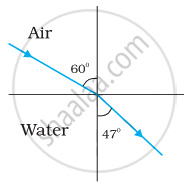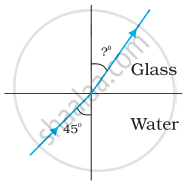Advertisements
Advertisements
प्रश्न
Why do stars twinkle?
उत्तर
- Light from the stars near the horizon reaches the earth obliquely through the atmosphere.
- It’s path changes due to refraction.
- Frequent atmosphere disturbances changes the path of light causes twinkling of stars.
APPEARS IN
संबंधित प्रश्न
Light of wavelength 5000 Å propagating in air gets partly reflected from the surface of water. How will the wavelengths and frequencies of the reflected and refracted light be affected?
Figures (a) and (b) show the refraction of a ray in air incident at 60° with the normal to a glass-air and water-air interface, respectively. Predict the angle of refraction in the glass when the angle of incidence in water is 45° with the normal to a water-glass interface [Figure (c)].
 |
 |
 |
| (a) | (b) | (c) |
An object P is focussed by a microscope M. A glass slab of thickness 2.1 cm is introduced between P and M. If the refractive index of the slab is 1.5, by what distance should the microscope be shifted to focus the object again?
What is angle of deviation due to refraction?
What is mirage?
Write a short note on the prisms making use of total internal reflection.
Derive the equation for acceptance angle and numerical aperture, of optical fiber.
When a ray of light is refracted from one medium to another, then the wavelength changes from 6000Å to 4000Å. The critical angle for the interface will be ______.
There are certain material developed in laboratories which have a negative refractive index (Figure). A ray incident from air (medium 1) into such a medium (medium 2) shall follow a path given by.
A convex lens made of material of refractive index 1.5 and having a focal length of 10 cm is immersed in a liquid of refractive index 3.0. The lens will behave as ______.
